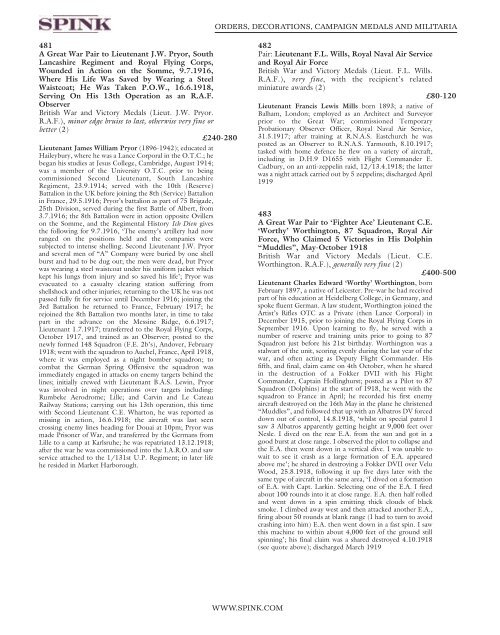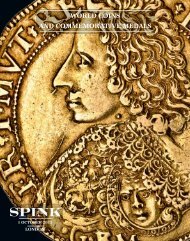orders, decorations, campaign medals and militaria - Spink
orders, decorations, campaign medals and militaria - Spink
orders, decorations, campaign medals and militaria - Spink
Create successful ePaper yourself
Turn your PDF publications into a flip-book with our unique Google optimized e-Paper software.
481<br />
A Great War Pair to Lieutenant J.W. Pryor, South<br />
Lancashire Regiment <strong>and</strong> Royal Flying Corps,<br />
Wounded in Action on the Somme, 9.7.1916,<br />
Where His Life Was Saved by Wearing a Steel<br />
Waistcoat; He Was Taken P.O.W., 16.6.1918,<br />
Serving On His 13th Operation as an R.A.F.<br />
Observer<br />
British War <strong>and</strong> Victory Medals (Lieut. J.W. Pryor.<br />
R.A.F.), minor edge bruise to last, otherwise very fine or<br />
better (2)<br />
£240-280<br />
Lieutenant James William Pryor (1896-1942); educated at<br />
Haileybury, where he was a Lance Corporal in the O.T.C.; he<br />
began his studies at Jesus College, Cambridge, August 1914;<br />
was a member of the University O.T.C. prior to being<br />
commissioned Second Lieutenant, South Lancashire<br />
Regiment, 23.9.1914; served with the 10th (Reserve)<br />
Battalion in the UK before joining the 8th (Service) Battalion<br />
in France, 29.5.1916; Pryor’s battalion as part of 75 Brigade,<br />
25th Division, served during the first Battle of Albert, from<br />
3.7.1916; the 8th Battalion were in action opposite Ovillers<br />
on the Somme, <strong>and</strong> the Regimental History Ich Dien gives<br />
the following for 9.7.1916, ‘The enemy’s artillery had now<br />
ranged on the positions held <strong>and</strong> the companies were<br />
subjected to intense shelling. Second Lieutenant J.W. Pryor<br />
<strong>and</strong> several men of “A” Company were buried by one shell<br />
burst <strong>and</strong> had to be dug out; the men were dead, but Pryor<br />
was wearing a steel waistcoat under his uniform jacket which<br />
kept his lungs from injury <strong>and</strong> so saved his life’; Pryor was<br />
evacuated to a casualty clearing station suffering from<br />
shellshock <strong>and</strong> other injuries; returning to the UK he was not<br />
passed fully fit for service until December 1916; joining the<br />
3rd Battalion he returned to France, February 1917; he<br />
rejoined the 8th Battalion two months later, in time to take<br />
part in the advance on the Messine Ridge, 6.6.1917;<br />
Lieutenant 1.7.1917; transferred to the Royal Flying Corps,<br />
October 1917, <strong>and</strong> trained as an Observer; posted to the<br />
newly formed 148 Squadron (F.E. 2b’s), Andover, February<br />
1918; went with the squadron to Auchel, France, April 1918,<br />
where it was employed as a night bomber squadron; to<br />
combat the German Spring Offensive the squadron was<br />
immediately engaged in attacks on enemy targets behind the<br />
lines; initially crewed with Lieutenant B.A.S. Lewin, Pryor<br />
was involved in night operations over targets including:<br />
Rumbeke Aerodrome; Lille; <strong>and</strong> Carvin <strong>and</strong> Le Cateau<br />
Railway Stations; carrying out his 13th operation, this time<br />
with Second Lieutenant C.E. Wharton, he was reported as<br />
missing in action, 16.6.1918; the aircraft was last seen<br />
crossing enemy lines heading for Douai at 10pm; Pryor was<br />
made Prisoner of War, <strong>and</strong> transferred by the Germans from<br />
Lille to a camp at Karlsruhe; he was repatriated 13.12.1918;<br />
after the war he was commissioned into the I.A.R.O. <strong>and</strong> saw<br />
service attached to the 1/131st U.P. Regiment; in later life<br />
he resided in Market Harborough.<br />
<strong>orders</strong>, deCoratioNs, CampaigN medaLs aNd miLitaria<br />
WWW.spiNK.Com<br />
482<br />
Pair: Lieutenant F.L. Wills, Royal Naval Air Service<br />
<strong>and</strong> Royal Air Force<br />
British War <strong>and</strong> Victory Medals (Lieut. F.L. Wills.<br />
R.A.F.), very fine, with the recipient’s related<br />
miniature awards (2)<br />
£80-120<br />
Lieutenant Francis Lewis Mills born 1893; a native of<br />
Balham, London; employed as an Architect <strong>and</strong> Surveyor<br />
prior to the Great War; commissioned Temporary<br />
Probationary Observer Officer, Royal Naval Air Service,<br />
31.5.1917; after training at R.N.A.S. Eastchurch he was<br />
posted as an Observer to R.N.A.S. Yarmouth, 8.10.1917;<br />
tasked with home defence he flew on a variety of aircraft,<br />
including in D.H.9 D1655 with Flight Comm<strong>and</strong>er E.<br />
Cadbury, on an anti-zeppelin raid, 12/13.4.1918; the latter<br />
was a night attack carried out by 5 zeppelins; discharged April<br />
1919<br />
483<br />
A Great War Pair to ‘Fighter Ace’ Lieutenant C.E.<br />
‘Worthy’ Worthington, 87 Squadron, Royal Air<br />
Force, Who Claimed 5 Victories in His Dolphin<br />
“Muddles”, May-October 1918<br />
British War <strong>and</strong> Victory Medals (Lieut. C.E.<br />
Worthington. R.A.F.), generally very fine (2)<br />
£400-500<br />
Lieutenant Charles Edward ‘Worthy’ Worthington, born<br />
February 1897, a native of Leicester. Pre-war he had received<br />
part of his education at Heidelberg College, in Germany, <strong>and</strong><br />
spoke fluent German. A law student, Worthington joined the<br />
Artist’s Rifles OTC as a Private (then Lance Corporal) in<br />
December 1915, prior to joining the Royal Flying Corps in<br />
September 1916. Upon learning to fly, he served with a<br />
number of reserve <strong>and</strong> training units prior to going to 87<br />
Squadron just before his 21st birthday. Worthington was a<br />
stalwart of the unit, scoring evenly during the last year of the<br />
war, <strong>and</strong> often acting as Deputy Flight Comm<strong>and</strong>er. His<br />
fifth, <strong>and</strong> final, claim came on 4th October, when he shared<br />
in the destruction of a Fokker DVII with his Flight<br />
Comm<strong>and</strong>er, Captain Hollinghurst; posted as a Pilot to 87<br />
Squadron (Dolphins) at the start of 1918, he went with the<br />
squadron to France in April; he recorded his first enemy<br />
aircraft destroyed on the 16th May in the plane he christened<br />
“Muddles”, <strong>and</strong> followed that up with an Albatros DV forced<br />
down out of control, 14.8.1918, ‘whilst on special patrol I<br />
saw 3 Albatros apparently getting height at 9,000 feet over<br />
Nesle. I dived on the rear E.A. from the sun <strong>and</strong> got in a<br />
good burst at close range. I observed the pilot to collapse <strong>and</strong><br />
the E.A. then went down in a vertical dive. I was unable to<br />
wait to see it crash as a large formation of E.A. appeared<br />
above me’; he shared in destroying a Fokker DVII over Velu<br />
Wood, 25.8.1918, following it up five days later with the<br />
same type of aircraft in the same area, ‘I dived on a formation<br />
of E.A. with Capt. Larkin. Selecting one of the E.A. I fired<br />
about 100 rounds into it at close range. E.A. then half rolled<br />
<strong>and</strong> went down in a spin emitting thick clouds of black<br />
smoke. I climbed away west <strong>and</strong> then attacked another E.A.,<br />
firing about 50 rounds at blank range (I had to turn to avoid<br />
crashing into him) E.A. then went down in a fast spin. I saw<br />
this machine to within about 4,000 feet of the ground still<br />
spinning’; his final claim was a shared destroyed 4.10.1918<br />
(see quote above); discharged March 1919

















